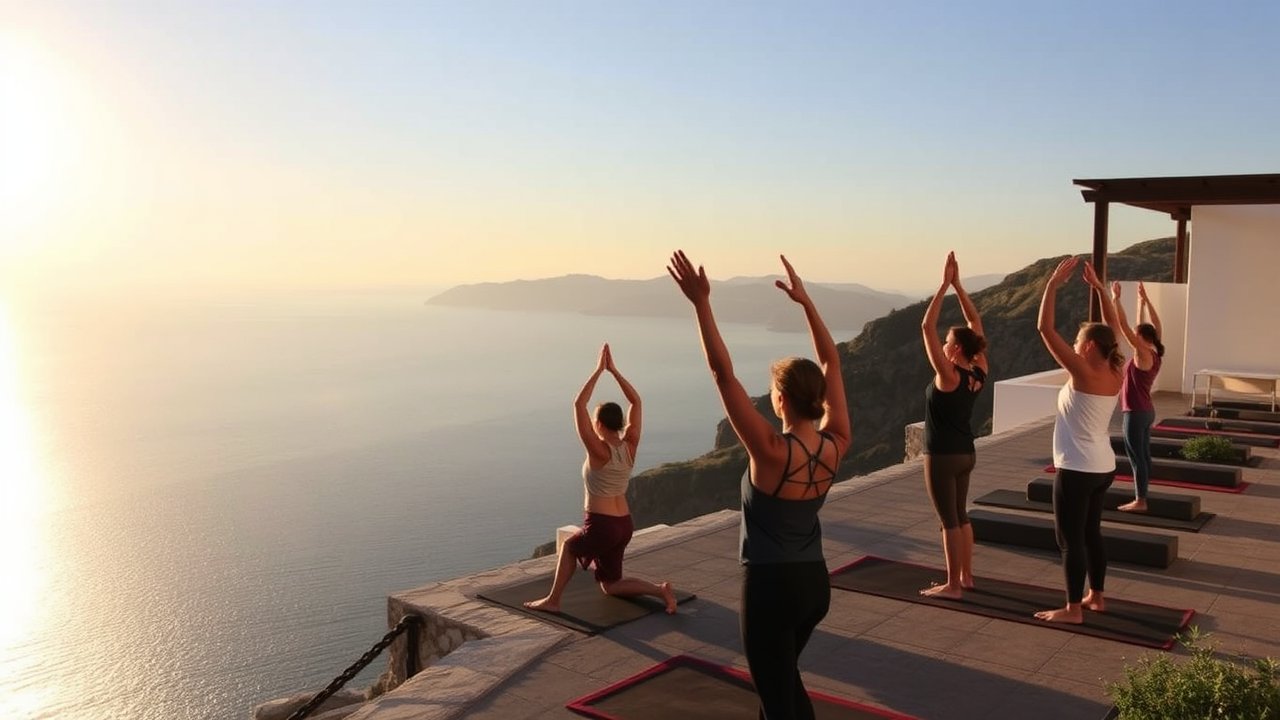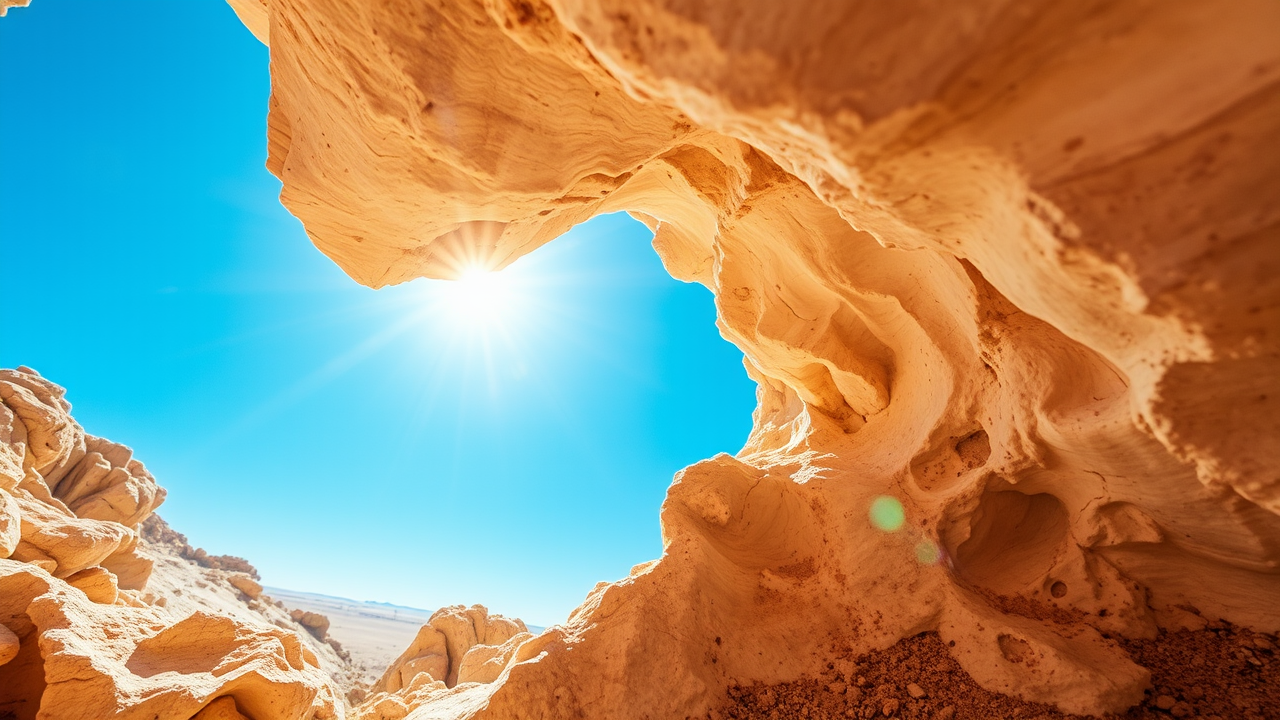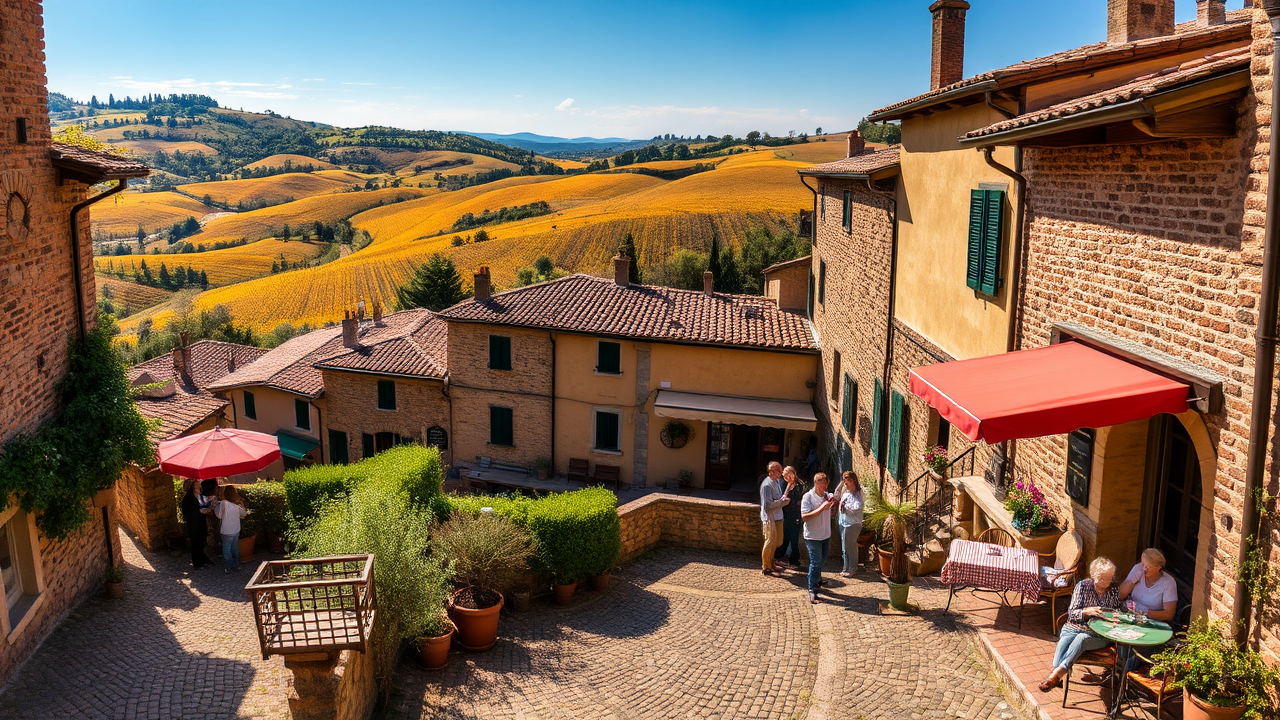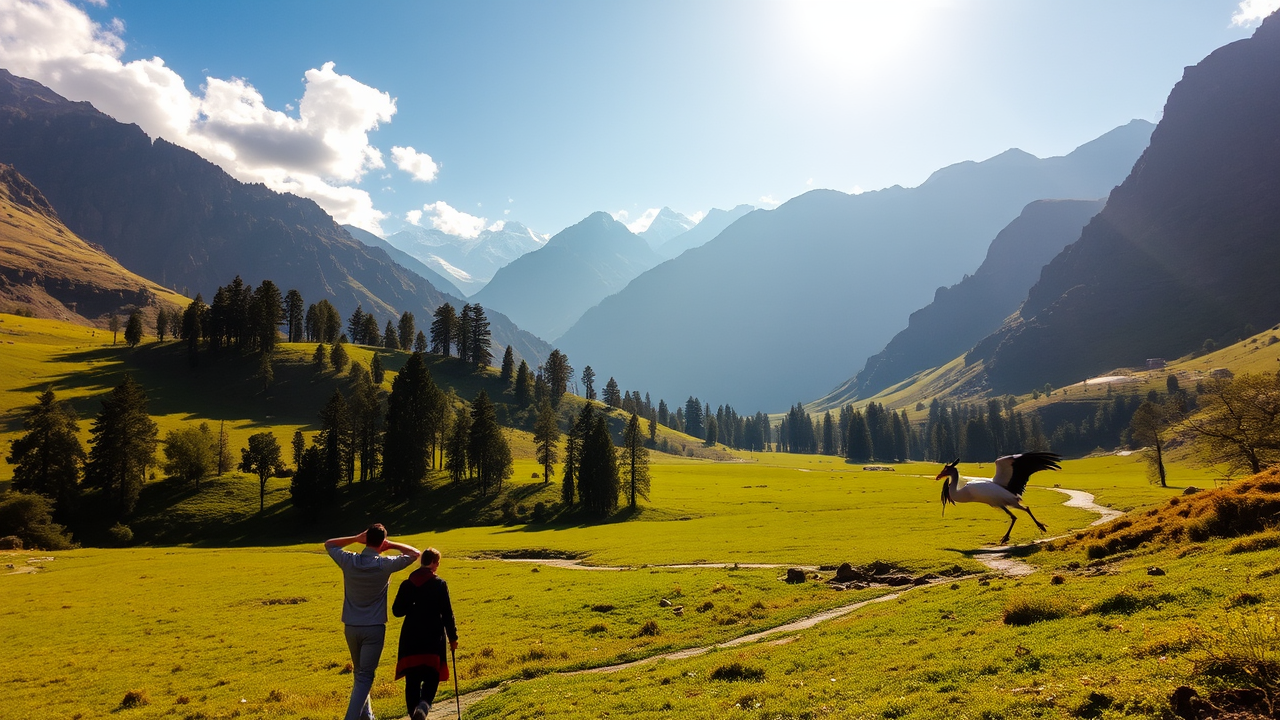# The Secret Life of Microorganisms: Discovering Ancient Life in Desert Rocks
When you think of the quiet vastness of desert landscapes, it’s easy to overlook the complex life thriving beneath the surface. Recent research has unveiled a fascinating, hidden world within the marble and limestone formations of desert regions in Namibia, Oman, and Saudi Arabia. In this blog post, we’ll explore the remarkable discoveries made by geologists and microbiologists, shedding light on the incredible adaptation of *endolithic* microorganisms and their potential impact on our understanding of life on Earth.
## An Unexpected Discovery
Professor Cees Passchier of Johannes Gutenberg University Mainz has dedicated over two decades to studying the geological makeup of Namibia. His research, primarily focused on the formation of the ancient supercontinent Gondwana, led to a surprising encounter with peculiar structures embedded in marble—small, tube-like burrows that appear to be the work of an unidentified microbiological life form.
While initially perceived as geological anomalies during fieldwork, further investigation revealed that these structures were anything but ordinary. They were not formed by natural geological processes but bore clear signs of biological activity. Imagine tiny tubes, measuring half a millimeter in diameter, extending up to three centimeters long and orientated in parallel lines—like miniature highways carved into the rock. What makes these findings even more astounding is that some of the structures span as much as ten meters!
## The Mystery Beneath the Surface
The journey to understand these enigma-like tubes has been ongoing for the last 15 years. What really piques researchers’ curiosity is the nature of the microorganisms responsible for this activity. Are they ancient life forms that have since gone extinct, or do they still exist hidden away in the rocks?
In a climate that was likely more humid during their creation, it’s believed these microorganisms utilized nutrients found within the calcium carbonate—the primary component of marble. The fine powder left behind in the burrows adds to the intrigue, hinting at a possible nutritional relationship between these organisms and the rock substrate.
## Endolithic Microorganisms: Nature’s Survivors
Endolithic microorganisms, which include bacteria, fungi, and lichen, have a remarkable ability to exist in harsh and extreme environments, even inside rocks. Their resilience indicates a sophisticated adaptation to survive without direct access to sunlight or traditional nutrients. As researchers delve deeper into these microorganisms’ biology, they are uncovering not only the survival strategies of life forms but also their roles in our planet’s ecosystems.
Passchier’s research team is working on categorizing these microorganisms, yet they have encountered one significant hurdle: the absence of DNA or protein samples, which complicates identification. The scientific community is buzzing with excitement about the implications of this discovery. These microorganisms could very well hold clues to our knowledge of ancient life and its connection to contemporary biological systems.
## Implications for the Earth’s Carbon Cycle
The potential impact of discovering new forms of life goes beyond scientific curiosity. Understanding the roles of these ancient microorganisms could provide insights into global carbon cycles. Microorganisms play a crucial role in the breakdown and recycling of carbon, influencing the Earth’s climate. Hence, the significance of Passchier’s discoveries may resonate in ongoing discussions about climate change, carbon sequestration, and ecological balance.
## Future Directions for Research
With the preliminary evidence pointing to unique life forms, Passchier encourages further explorations into the hidden microbiology of these desert regions. Multi-disciplinary research is essential to unlock the mysteries of these ancient structures. Collaboration between geologists, microbiologists, and climate scientists will be key to piecing together the ecological puzzle of life beneath the Earth’s surface.
Given the likelihood of untapped microbial biodiversity, researchers are calling on specialists in endolithic life forms to expand investigations into these desert habitats. It remains uncertain whether the organisms are still active, but studying their ancient structures could pave the way for new scientific fields of inquiry.
## Conclusion: A Glimpse into the Unknown
As we ponder the resilient organisms dwelling within the rock layers of our planet, we are reminded of the delicate interplay of life in even the most seemingly inhospitable environments. The quest to understand these microorganisms opens doors to not only expanding our knowledge of biodiversity but also holding essential clues about our Earth’s history and future.
Who knows what fascinating secrets await discovery in regions like Namibia, Oman, and Saudi Arabia? Whatever the outcome, the journey of exploration in search of life’s mysteries serves as a powerful reminder of nature’s perseverance and ingenuity.
## Tags:
#Microorganisms #EndolithicLife #DesertLife #Geology #ClimateResearch #Biodiversity #AncientMicrobes #GlobalCarbonCycle
—
# From Desert Stones to Microbial Mysteries: The Life Below Our Feet
Have you ever gazed upon the barren beauty of a desert landscape and thought about the life teeming in its hidden depths? Scientists have made an incredible discovery beneath the dusty surface of marble and limestone in deserts across Namibia, Oman, and Saudi Arabia. This blog post will take you on a journey through the scientific findings that reveal the surprising world of microorganisms adapting to one of Earth’s harshest environments.
## A Geologist’s Discovery
In the rugged landscapes of Namibia, Professor Cees Passchier embarked on geological explorations that led to an astonishing revelation. Engaged in reconstructing the geological history of the Precambrian era, his team stumbled upon peculiar structures deep within the rock formations—tiny tubes that appeared to be carved out of the descending layers of marble.
What sparked curiosity among the researchers was the realization that these formations were not the product of natural erosion or geological forces. Rather, they bore unmistakable signs of biological activity. The team quickly uncovered parallel arrangements of tiny burrows, measuring a mere half a millimeter in diameter yet extending up to ten meters in length.
## The Scientific Investigation
The journey does not end with their discovery—researchers quickly sought to understand the origins of these ancient tubes. The enduring question loomed: Who created them? What kind of organisms were capable of surviving and thriving inside solid rock?
Through extensive analysis, the researchers identified indicators that pointed toward the presence of microorganisms. They hypothesized that endolithic microorganisms—an awe-inspiring category known for inhabiting the insides of other organisms or, in this case, rock—were involved. These organisms have the unique ability to derive nutrients from their rocky surroundings, showcasing nature’s adaptability.
## Not Just Rocks and Sand
The findings challenge our perception of what constitutes a habitat. Prof. Passchier notes that these structures are remnants of organisms once thriving in an environment very different from the arid conditions we see today. The microorganisms may have existed during a period characterized by greater humidity, crafting an intricate network of tunnels to access the vital nutrients sequestered within the rock matrix.
The complexity of this relationship highlights the adaptability of life forms, adapting to harsh conditions by tapping into geological resources in ways we have yet to fully understand.
## The Bigger Picture: What Lies Beneath
As we explore the importance of these microorganisms, we realize their potential implications extend far beyond geology and ecology. The role of these surface-dwelling life forms may be crucial to understanding the global carbon cycle, which, in turn, plays a significant role in climate change discussions.
The carbon released by these microorganisms as they interact with the rock solidifies connections between ancient times and our current climate phenomenon. By studying these microorganisms, researchers aspire to gain more insights into climate moderation, nutrient cycling, and environmental adaptability.
## The Call to Action
As research progresses, Passchier advocates for awareness within the scientific community regarding this extraordinary discovery. He urges exploration into how these unknown microorganisms influence the Earth’s ecosystems, and whether they exist in similar formations elsewhere.
The time is ripe for collaboration among microbiologists, geologists, and climate scientists to unveil answers to myriad questions surrounding these rock-boring life forms.
## Conclusion: Nature’s Hidden Wonders
Unraveling the mysteries of endolithic microorganisms serves as a powerful reminder of life’s resilience and adaptability. Each little tube carved into desert rock tells a story of survival against the odds. It sparks our curiosity and reminds us that beneath our feet lies a rich tapestry of life waiting to be unveiled.
Beneath the sun-baked crust of our planet exists a world teeming with hidden wonders and life forms that defy our expectations. By encouraging and facilitating further research, we might just scratch the surface of understanding all the life — both ancient and modern — that exists in these seemingly desolate regions.
## Tags:
#DesertExploration #MicrobialLife #GeologicalDiscovery #Endoliths #ClimateChange #ScientificResearch #Biodiversity #LifeInExtremeEnvironments
—
# Beneath the Surface: Unlocking the Secrets of Endolithic Microorganisms in Desert Rocks
Deserts may appear lifeless at first glance, but recent research has unveiled a surprising narrative of life beneath the surface. In an astonishing turn of events, scientists made a groundbreaking discovery of ancient microorganisms nestled within the marble and limestone of Namibia, Oman, and Saudi Arabia. This blog post delves into the intriguing world of endolithic life and its potential implications for our understanding of ecological balance and carbon cycling.
## A Geologist’s Eye for Detail
It was during fieldwork in Namibia that Cees Passchier, a geologist at Johannes Gutenberg University Mainz, first noticed unusual structures in the sedimentary layers of marble—a series of tubes weaving through the rock. Initially dismissed as mere geological phenomena, upon further inspection, the team recognized these formations were distinctly biological in nature.
The tubes—some up to ten meters long—reveal a well-organized pattern unlike any geological process. Created by unknown microorganisms, these structures provoke a sense of wonder. What kind of organisms could thrive in such harsh environments? How do they survive in total darkness, deep within solid rock?
## The Art of Microbial Engineering
Upon further investigation, researchers likened these structures to the work of *endolithic* microorganisms. These remarkable organisms possess an innate skill to extract nutrients from their rocky habitats. By tunneling through the rock, they actively participate in their environment, crafting a unique interaction between geology and biology.
It’s a fascinating concept to imagine: tiny tube-like corridors shaped by microorganisms as they search for sustenance and shelter. This relationship sheds light on the extreme adaptability of life. Even in seemingly barren deserts, organisms have evolved diverse methods for survival, including leveraging rock as a nutrient source.
## Geological Time and Life Cycles
Researchers speculate these tubes were formed during a more humid climate, long before deserts dominated the landscape. With assumptions pointing to their age — approximately one to two million years — it raises critical inquiries regarding the ecological changes over millennia.
What environmental transformations allowed such structures to exist? Such investigations can provide valuable context to our understanding of climatic shifts and their lasting impact on life.
## Significance for Climate Science
Given the vast implications of these findings, researchers underline the necessity of studying these microorganisms’ roles in the global carbon cycle. It is conceivable that this ancient microbial activity participates in carbon release, ultimately influencing our Earth’s overall carbon strategies and climate discourse.
Understanding these dynamics is crucial for tackling ongoing environmental challenges. By delving deep into endolytic life forms, scientists may unlock new approaches to ecological management and carbon sequestration solutions.
## Transitioning into Future Research
Given the mystery surrounding these microorganisms, it poses an exciting challenge for microbiologists. The research team urges the scientific community to pay attention to this overlooked aspect of microbial life. What remains unexplored in desert habitats could alter our understanding of life’s complexity on Earth.
Collaborative efforts among disciplines will be instrumental in expanding knowledge about the microbial life woven into the fabric of our planet’s geology.
## Conclusion: A Mosaic of Life Awaits Discovery
The hidden life encapsulated in desert rocks invites us to challenge preconceived notions of where life can thrive. As we unravel the layers of evidence left behind by ancient microorganisms, we come to appreciate the intricate connections that form the basis of our planet’s ecosystems.
The unique findings encourage further exploration for scientific inquiries, offering ample opportunities for future generations to build upon this foundation of knowledge.
Life, it seems, knows no bounds—even in the seemingly desolate sectors of our world, it finds a way to thrive.
## Tags:
#LifeInDeserts #MicrobialTechnology #EndolithicMicroorganisms #GeologyAndBiology #EnvironmentalScience #CarbonCycle #EcologicalResearch #HiddenLife
—
# Unveiling Ancient Life: The Untold Story of Microorganisms in Desert Rocks
Imagine strolling through the arid expanse of a desert, seemingly barren and devoid of life. Yet, beneath our very feet lies a narrative of survival and curiosity—intriguing discoveries of ancient microorganisms living in the rocks of Namibia, Oman, and Saudi Arabia. In this blog post, we’ll unravel the secrets held within these formations, exploring the existence and significance of *endolithic* life in the world’s most extreme environments.
## The Beginning of Discovery
Professor Cees Passchier, a geologist dedicated to unearthing the mysteries of the Earth’s past, found himself captivated by unusual structures while conducting research in Namibia. Within the marble and limestone rocks, he encountered a series of tiny tubes that sparked a new scientific inquiry.
Initially attributed to geological processes, subsequent examinations revealed that these formations arise from biological activity. What emerged was a fascinating inquiry: the origins of these microbial structures remain unknown. Did they belong to bygone life forms or are they part of an undiscovered family of microorganisms?
## Life in the Shadows: Understanding Endolithic Microorganisms
The investigation takes us into the intriguing realm of *endolithic* microorganisms, which reside within the mineral matrix of rocks. These remarkable organisms have evolved to extract nutrients in exhilarating ways, navigating life without light and adapting to harsh climatic conditions.
The structures observed reflect the ingenious methods of survival employed by these tiny life forms. By creating tunnels and burrows, they open pathways to access essential nutrients within the solid rock. This symbiotic relationship compels us to reconsider our notions of what constitutes a habitat.
## Geological Insights and Climate History
Endolithic microorganisms are believed to have thrived in conditions distinct from the current deserts we see today. This hypothesis points to a significant climatic shift that needs further exploration. By understanding these microorganisms and the geology they inhabit, we can gain insight into historical climate patterns.
What do these ancient structures tell us about Earth’s climatic story? Dissecting their relationship with the environment allows researchers to piece together the chronicle of ancient ecosystems and their transitions across time.
## The Role in the Carbon Cycle
The discussions don’t end here; we must consider the microorganisms’ significance within the global carbon cycle. Microbial life undoubtedly impacts carbon cycling and ecosystem health. By comprehensively studying these endolithic forms, researchers can better understand how they contribute to carbon release and overall ecological stability.
As scientific communities grow aware of these microorganisms, the discussions surrounding climate change and carbon management become enriched with new insights.
## Looking Ahead: Research Possibilities
The discoveries made by Professor Passchier and his team highlight a call for increased scientific attention toward endolithic microorganisms. Collaborations among microbiologists, geologists, and climate scientists could lead us to uncharted territories within this fascinating field of study.
Encouraging future explorations will allow researchers to document findings further and unveil more about the hidden life within rock formations.
## Conclusion: A Journey of Discovery
The ongoing revelations surrounding microorganisms in desert rocks invite us to ponder the resilience and adaptability of life on Earth. As we venture through these discoveries, we become more attuned to nature’s intricate web, continuously finding clues that emphasize the connections between ancient history and present-day environmental challenges.
So the next time you’re wandering through a desolate landscape, remember that life is not always apparent. Beneath the surface, ancient mysteries await those curious enough to explore.
## Tags:
#MicrobialDiscovery #EndolithicOrganisms #DesertEcosystems #GeologicalEnquiry #ClimateScience #CarbonCycle #HiddenBiodiversity #Exploration









